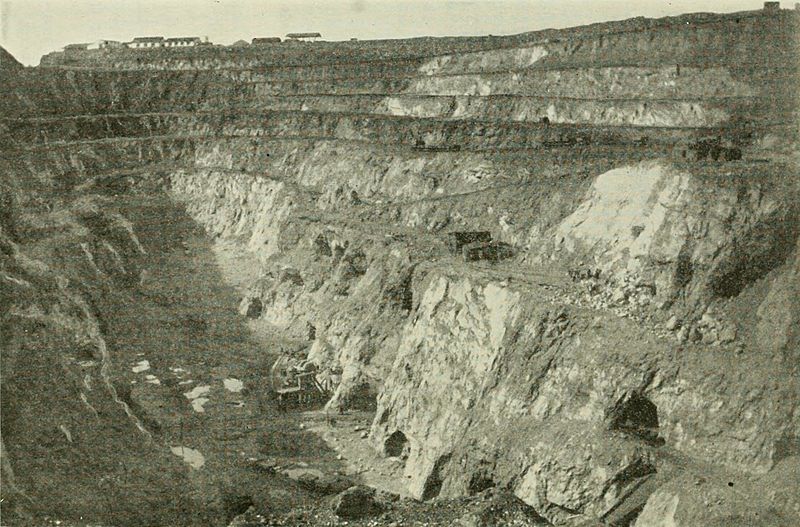Archivo: Steam shovel mining, including a consideration of electric shovels and other power excavators in open-pit mining (1920) (14576508918)

Descripción: Identifier: steamshovelminin00marsuoft (find matches) Title: Steam shovel mining, including a consideration of electric shovels and other power excavators in open-pit mining Year: 1920 (1920s) Authors: Marsh, Robert, Jr Subjects: Mining engineering Steam shovels Publisher: New York McGraw-Hill Contributing Library: Gerstein - University of Toronto Digitizing Sponsor: University of Toronto View Book Page: Book Viewer About This Book: Catalog Entry View All Images: All Images From Book Click here to view book online to see this illustration in context in a browseable online version of this book. Text Appearing Before Image: .—One of the oldest and mostinteresting examples of open-cast work is found at Rio Tinto,Province of Andalusia, southern Spain. This district wasknown as Tarshish in the Bible and as Tartessus in classic days,and to it is attributed the silver and much of the gold whichformed the mainstay of the wealth of Tyre. Thus its historydates from the remotest antiquity, when it was worked by thePhoenicians, and later by the Romans. These ore deposits are essentially great lenticular bodies ofcopper-bearing iron pyrites, but their upper portions were soenriched by decomposition that they yielded good returns insilver and gold, and in enriched copper ores which were smeltedin little furnaces. Great heaps of old slag found about themines testify to the large amount of ore extracted and the excel-lence of the metallurgy, the labor of which must have covered 1 STEAM SHOVEL MINING a long period. Part of this work was in the form of open-casts,as they are termed, and part was underground galleries. Text Appearing After Image: After a time of inactivity these mines were again exploitedby the Spaniards, but they had a rather checkered careeruntil 1872 when those at Rio Tinto were sold to London and THE POWER SHOVEL 3 Bremen capitalists. The new owners continued to work tlu;open-casts with hand-labor, but with the cost of productionsteadily increasing. The owners of other mines in the districtemployed the same method, and even until 1911, when thewriter visited the district, the Zarza mine of the Tharsis Com-pany was being so worked in the open-cast portion. Increasingdepth and higher cost of labor have forced the operators to seekmore economical methods with the result that the Rio TintoCompany has adopted steam-shovel methods; the TharsisCompany, because of its topography, has developed and adoptedunderground mining methods. A study of these mines serveswell to exemplify the history of open-cast mining from the earliestto the present time. Figs. 1 and 2 illustrate the appearancein September 1911 of two of tsteamshovelminin00marsuoft Note About Images Please note that these images are extracted from scanned page images that may have been digitally enhanced for readability - coloration and appearance of these illustrations may not perfectly resemble the original work.
Título: Steam shovel mining, including a consideration of electric shovels and other power excavators in open-pit mining (1920) (14576508918)
Créditos: https://www.flickr.com/photos/internetarchivebookimages/14576508918/ Source book page: https://archive.org/stream/steamshovelminin00marsuoft/steamshovelminin00marsuoft#page/n15/mode/1up
Autor(a): Internet Archive Book Images
Permiso: At the time of upload, the image license was automatically confirmed using the Flickr API. For more information see Flickr API detail.
Términos de Uso: No known copyright restrictions
Licencia: No restrictions
Enlace de Licencia: https://www.flickr.com/commons/usage/
¿Se exige la atribución?: No
Usos del archivo
Las siguientes páginas enlazan a este archivo:

